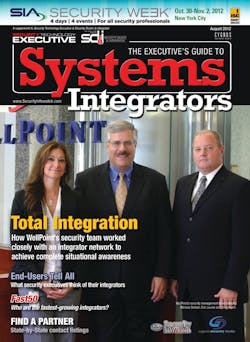From any given chair in the conference room of his corporate security command center, Eric Levine can see the world — or, at least the parts of the world that matter most to him.
Within the walls of his state-of-the-art Corporate Situational Awareness and Response Center, or CSARC, Levine has a window into each of his company’s locations, as well as instant access to incidents and events happening around the world that could potentially impact business operations.
For Levine, vice president and director of corporate security for WellPoint Inc., one of the nation’s largest health benefits company, having access to such situational awareness was the focus of a recent security upgrade project. The multi-year, multi-phase project so far has resulted in the design and construction of CSARC as well as the beginnings of an access control modernization and standardization project for WellPoint regional offices in North America and around the globe.
Multi-Location Challenges
Amassed though a series of mergers and acquisitions spread across 10 years and 14 states, WellPoint’s network of approximately 120 locations are very different in size, type and business function. By nature of acquisition, the facilities also featured a diverse mix of access control platforms, several types of employee credentials and a mix of legacy surveillance equipment. The acquisitions also included eight regional command centers across the country — originally designed to handle small networks of locations in one or more states.
Levine and his team evaluated WellPoint’s security infrastructure and overall exposure to risk with a comprehensive risk assessment. After identifying the overall risks to the enterprise from the traditional security side, Levine and his team determined that they needed to move WellPoint’s corporate security operations toward a more intelligence-based, proactive approach.
“We needed to be able to bring all of our disparate information that we had out in the field and be able to distill and analyze it from a central location,” Levine says. “CSARC is the heart of our operations and enables us to make decisions swiftly and intelligently.”
Security Overhaul Ensures Situational Awareness
From his corporate headquarters location in Indianapolis, Levine enlisted the help of Indianapolis-based Koorsen Security Technology, a member of Security-Net, a national network of systems integrators. The first order of business was to perform a cost-benefit analysis of consolidating the smaller, regional command centers into a central location. At the same time, Levine’s team created WellPoint’s first set of security standards for the company, and an execution plan to standardize all regional locations on the Honeywell ProWatch security management system — which meant re-badging the company’s approximately 37,000 associates.
Armed with data demonstrating the three-year ROI of consolidating the command centers, Koorsen designers worked with Levine and his team to design of the 3,200-square-foot CSARC command center, which would feature a massive, 10x6-foot LCD video wall from Christie Digital and situational readiness software from NC4.
From the central monitoring console, three full-time operators are able to view on the video wall camera feeds from the company’s remote locations and active alarm monitoring functions from the access control system — all cross-referenced with a large situational map that Koorsen integrated with the NC4 software. Several LCD screens also broadcast news from CNN, other global news channels and live global weather monitoring.
Inside the Command Center
The video wall is the heart of the command center, and it features two unique components conceived and designed by Koorsen Security and another Security-Net member, Operational Security Systems (OSS) of Atlanta. First, thanks to a cooperative effort between the integrators and engineers at Christie Digital, the video wall has no gaps between the individual screens. “It was crucial for WellPoint operators to have this level of sophisticated integration viewed on a very large, crystal clear display to easily be able to distill and analyze all the information pouring into the CSARC,” says Skip Sampson, vice president of Koorsen Security.
OSS engineers were then able to write a software interface to enable the NC4 mapping and situational readiness software and access control system to integrate seamlessly for true command-and-control functionality in the CSARC. In the event of an incident occurring within a set distance from a WellPoint facility, the integration with NC4 enables video and access control data from that particular facility to quickly pop up on the video wall.
“The uniqueness of our system is Koorsen and Security-Net’s integration of NC4’s technology into the system, the cameras, and ProWatch to release doors from a central location,” Levine says. “Now, we know how far an incident may be from one of our locations, and no matter if it is 30 miles from us or across the country — we can take action from the CSARC.”
While each regional location has the ability for local alarm and surveillance monitoring onsite, CSARC operators will take over in the event of an alarm not addressed within a certain time period.
This allows CSARC operators to be aware of system events and act as a central communications hub for WellPoint security without being overwhelmed by the volume of alarms during the transition from legacy to the updated access control systems.
CSARC operators are not limited to their seat at the central console for command and control. OSS engineers also enabled control of the integrated system via iPad, so WellPoint security officials can remotely access the system from home during off hours or while traveling.
Under the guidance of Melissa Serban, CSARC operations manager, operators in the command center can also track traveling WellPoint executives and employees, ensuring their whereabouts and safety in the event of a global incident. CSARC staff has also been successful in warding off potential incidents around WellPoint facilities, such as planned demonstrations, because of the intelligence capabilities and industry connections of Serban and her staff.
The watchful eye of CSARC has also benefitted entities outside of WellPoint, and helped law enforcement communities local to WellPoint solve some major crimes, including a recent homicide and a bank robbery.
Progressing to Total Integration
To date, nearly 28 sites have been converted by Koorsen to the ProWatch system, and to Honeywell’s LobbyWorks visitor management system, another part of the standardization process.
More than 300 cameras are online and being fed into the CSARC, with several large locations currently underway. All sites are also being connected via an enterprise-wide IP intercom system for direct communication to the command center.
Greg Wurm, WellPoint director of domestic security operations, is serving as the project manager and overseeing Security-Net members in several other states as the upgrade projects are completed. In all, 12 Security-Net members are engaged in security upgrades on WellPoint regional locations.
As WellPoint continues to standardize and modernize its multiple locations, Security-Net technical expertise and geographic coverage was a crucial element to satisfying WellPoint’s need for instant access and analysis of crucial information. With CSARC as the hub, WellPoint is well on its way to deriving the benefits of a totally integrated, standardized solution.
This article originally appeared in the 2012 Executive's Guide to Systems Integrators.
About the Author
Paul Rothman
Editor-in-Chief/Security Business
Paul Rothman is Editor-in-Chief of Security Business magazine. Email him your comments and questions at [email protected]. Access the current issue, full archives and apply for a free subscription at www.securitybusinessmag.com.

